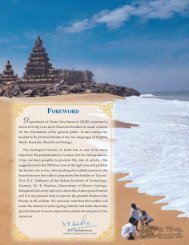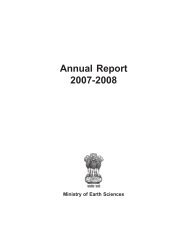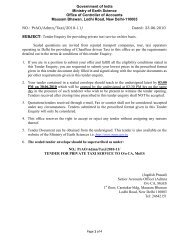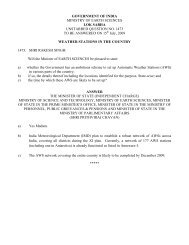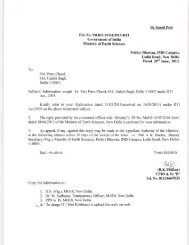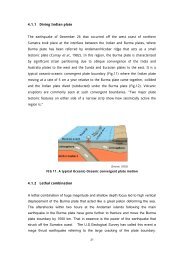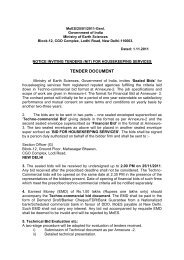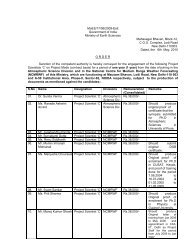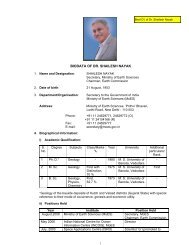1) Microzonation main Volume - Ministry Of Earth Sciences
1) Microzonation main Volume - Ministry Of Earth Sciences
1) Microzonation main Volume - Ministry Of Earth Sciences
- No tags were found...
You also want an ePaper? Increase the reach of your titles
YUMPU automatically turns print PDFs into web optimized ePapers that Google loves.
EXECUTIVE SUMMARYSeismic hazard and microzonation of cities enable us to characterize the potential seismic areas that need tobe taken into account when designing new structures or retrofitting the existing one. Study of seismichazard and preparation of geotechnical microzonation maps will provide an effective solution for cityplanning and input to earthquake resistant design of structures in an area. In the present study an attempt ismade to characterize the site and to study the seismic hazard analysis considering the local site effects andto develop microzonation maps for Bangalore. Seismic hazard analysis with local site and microzonation ofBangalore is addressed in three parts: The first part provides estimation of seismic hazard usingseismotectonic and geological information. From hazard studies it found that expected peak groundacceleration (PGA) for Bangalore at rock level is about 0.15g using deterministic approach (0.136g usingsynthetic ground motion model). Seismic hazard parameter ‘b’ value is estimated as 0.87, which is slightlyhigher than the published values, indicating high activity of the region. The uncertainty involved in thehazard analysis is quantified using probabilistic approach which gives similar peak ground acceleration of0.121g. Second part deals with site characterization using geotechnical and shallow geophysical techniqueof multichannel analysis of surface wave (MASW). Based on soil average shear wave velocity and 30maverage shear wave velocity, as per National <strong>Earth</strong>quake Hazards Reduction Program (NEHRP) andInternational Building Code (IBC), Bangalore can be classified as “Site class D”. Correlation betweencorrected standard penetration test (SPT) ‘N’ values and measured shear wave velocity has been developed.There were over 150 lakes in Bangalore Mahanagar Palike, though most of them are dried up due toerosion and encroachments leaving only 64 at present in an area of 220 km 2 . The classification as site classD and filled up soils in encroachments emphasize the need to study site effects. In the last part, local siteeffects are assessed by carrying one-dimensional (1-D) ground response analysis (using the programSHAKE 2000) using both borehole SPT data and shear wave velocity survey data within an area of 220km 2 . 1-D site response study shows that the amplification factor is in the range of 1 to 4.7 and predominantfrequency varies from 2 Hz to 12Hz. Ground response parameters evaluated using MASW data showslightly lower values when compared to the parameters obtained using SPT data. Correlation betweencorrected SPT ‘N’ values and low strain shear modulus has been developed. Further, field experimentsusing microtremor studies have also been carried out (jointly with NGRI) for evaluation of predominantfrequency of the soil columns. Predominant frequency obtained from all the three methods matches verywell. Further, Seed and Idriss simplified approach has been adopted to evaluate the liquefactionsusceptibility and liquefaction resistance assessment. Liquefaction study shows that Bangalore is safeagainst liquefaction except at few locations where the overburden is sandy silt with presence of shallowwater table. From this study about 31 <strong>Microzonation</strong> maps have been prepared for Bangalore city on a scaleof 1:20000 and correlation between SPT corrected N values to measured shear wave velocity and low strainshear modulus have also been generated. The rocklevel PGA map for 2 ½ and 10 % probability ofexcedence in 50 years corresponding to the return period of 2475 and 475 years has been presented. Thestudy brings out that both the probabilistic and deterministic approaches lead to similar answer andprovides an insight to the seismic hazard assessment.VI




